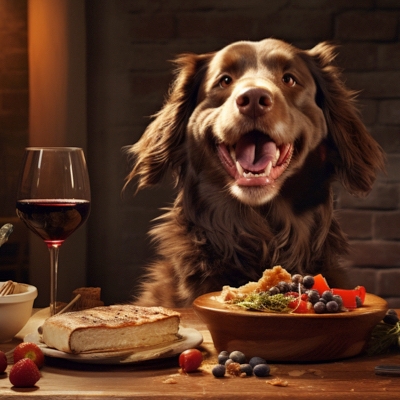From Kibble to Gourmet:
The Evolution of Pet Food in the Modern Age
Summary:
The evolution of pet food has been a remarkable journey, transitioning from simple table scraps to scientifically formulated, gourmet options. This transformation reflects not only advances in our understanding of pet nutrition but also a cultural shift in how we view our pets—as integral members of our families deserving of specialized care. Today, pet owners can choose from a wide array of options, including organic, non-GMO, and chef-crafted meals that prioritize both taste and health. However, this evolution also raises important questions about the environmental impact of pet food production and the choices we make as responsible pet parents. As we look to the future, the pet food industry is poised for further innovation, driven by our deepening bond with our pets and our commitment to their well-being.


- The Humble Beginnings of Pet Food
- The Rise of Commercial Kibble
- Nutritional Revolution: Understanding Pet Needs
- The Gourmet Era: A New Wave of Pet Food
- The Raw Food Movement
- Organic and Non-GMO Options
- The Humanization of Pet Food
- The Future of Pet Food: Trends to Watch
- The Environmental Impact of Pet Food Production
- Making the Right Choice: Tips for Pet Owners
In the bustling aisles of your local pet store, amidst the colorful bags and cans adorned with happy, frolicking animals, lies a tale as rich and varied as the flavors on offer. From the basic kibble that our grandparents fed their furry friends, to today's gourmet, chef-crafted meals that could make a human's mouth water, pet food has undergone a remarkable transformation. This evolution is not just about taste; it’s a story of science, health, culture, and love for our four-legged family members. Join us on a journey from kibble to gourmet, as we explore the fascinating evolution of pet food in the modern age.
In the early 20th century, pet food was a far cry from the diverse and specialized options we have today. Dogs and cats were often fed table scraps, raw meat, and grains that were mixed at home. There was little understanding of the specific nutritional needs of pets, and the concept of pet food as a separate category of food production was virtually nonexistent. It wasn't until James Spratt, an electrician from Ohio, introduced the first commercially prepared pet food in the 1860s, that the industry began to take shape. Spratt's formula, a mix of wheat, beetroot, and beef blood, was the first step towards the commercial pet food industry we know today. It was designed to be more convenient than feeding pets table scraps, and it tapped into a growing awareness of the need to provide specific nutrition for pets.
As the 20th century progressed, advances in food processing technology and a deeper understanding of animal nutrition led to the development of kibble as we know it. The convenience of dry, long-lasting, and easy-to-store food made kibble an instant success with pet owners. Brands like Purina, which launched its first dog chow in 1956, capitalized on this trend, investing in research to develop formulas that were not only convenient but also nutritionally balanced. Today, kibble remains a staple in the pet food market, with countless brands and varieties catering to the specific needs of different breeds, ages, and health conditions of pets. It is a testament to the enduring appeal of convenience, even as our understanding of pet nutrition continues to evolve.
In the mid-20th century, as science began to play a more significant role in pet care, veterinarians and nutritionists started to understand the unique dietary needs of pets. Research led to the discovery of essential nutrients, vitamins, and minerals that pets require for optimal health. This period marked a shift from pet food as a mere convenience to a scientifically formulated product designed to promote health and longevity. Brands began to work closely with veterinarians to create diets targeting specific health issues, such as kidney disease or obesity, transforming pet food into a tool for preventive healthcare.
Enter the 21st century, and pet food has taken a decidedly gourmet turn. Today’s pet food aisles are replete with options that sound more like a five-star menu than animal feed—wild salmon pâté, grass-fed lamb, and organic pumpkin puree, to name a few. This gourmet era is not just about tantalizing our pets' taste buds; it's about offering whole, real ingredients that pet parents can recognize and feel good about. It reflects a broader trend of humanization in pet care, where pets are considered family, and what’s good for us is deemed good for them.
In recent years, the raw food movement has gained traction among pet owners seeking a more ‘natural’ diet for their pets. This diet typically consists of raw meat, bones, fruits, and vegetables. Proponents argue that it more closely mimics the diet of wild ancestors, promoting better health and vitality. However, it's a topic that has sparked debate among veterinarians and pet nutrition experts, with concerns about bacterial contamination and the balance of nutrients. It’s a poignant example of how pet food trends can sometimes mirror human food trends, for better or worse.
As people become more health-conscious and environmentally aware, these values are increasingly reflected in the choices they make for their pets. Organic and non-GMO pet foods are on the rise, appealing to owners who seek the purest and most natural ingredients for their furry friends. These options often avoid synthetic pesticides, artificial preservatives, and genetically modified ingredients, aligning pet food choices with broader lifestyle and values.
The term "humanization of pet food" refers to the trend of pet foods that are comparable in quality to human food. This includes not only the use of high-quality, recognizable ingredients but also the adoption of human food trends, such as gluten-free, non-GMO, and locally sourced ingredients. This trend reflects the deep emotional bond between people and their pets, with pet parents seeking to extend their own food values and lifestyle choices to their furry family members.
As we look to the future, sustainability is set to play a significant role in the pet food industry. With growing awareness of the environmental impact of pet food production, from the resources used in farming to the packaging that ends up in landfills, there is a clear trend towards more sustainable practices. Innovations like insect-based proteins, lab-grown meats, and biodegradable packaging are just a few of the trends that could redefine what it means to feed our pets responsibly.
The pet food industry, like many others, comes with its environmental costs. From the land and water used to grow ingredients to the energy consumed in production and transportation, pet food has a definite ecological footprint. As consumers become more eco-conscious, there is increasing demand for pet food companies to adopt sustainable practices, whether that’s through sourcing responsibly farmed ingredients, reducing waste in production, or opting for more sustainable packaging solutions.
Choosing the right food for your pet in today’s saturated market can feel overwhelming. It’s essential for pet owners to consult with a veterinarian who understands their pet’s unique needs and can guide them towards the most nutritionally appropriate options. Reading and understanding labels, considering the environmental impact of your choice, and being wary of fad diets that aren’t backed by science are all crucial steps in making an informed decision for your pet’s health and happiness.
As we stand in the pet food aisle, with more options than ever before, we are not just choosing a meal for our pets; we are making a statement about our values, our understanding of nutrition, and our commitment to the well-being of our beloved companions. The evolution from kibble to gourmet is not just a trend; it is a reflection of the deepening bond between humans and their pets, and a testament to the lengths we will go to ensure they are healthy and happy. As we look to the future, one can only wonder: what's the next chapter in this ever-evolving story of love, care, and kibble?


